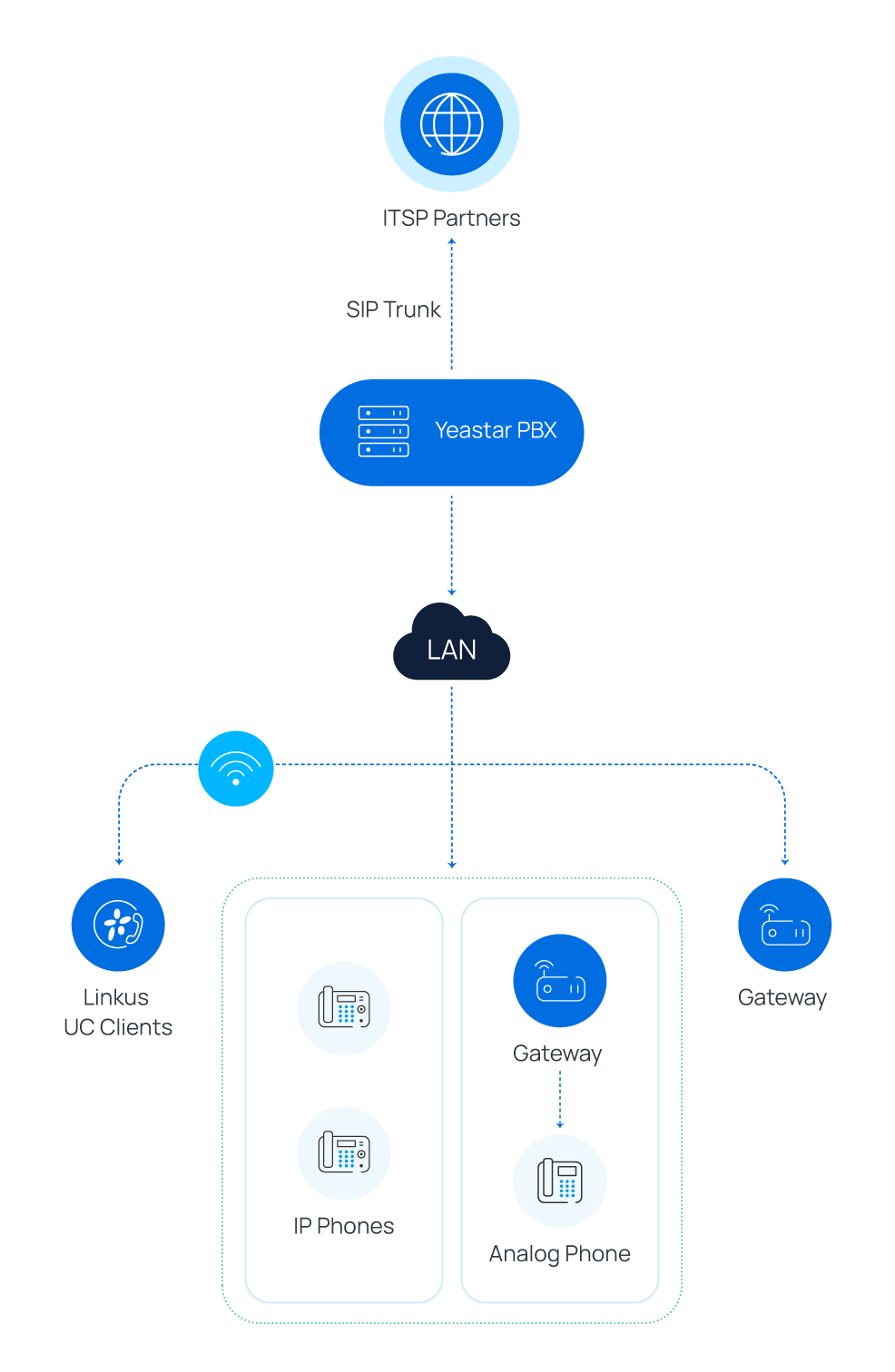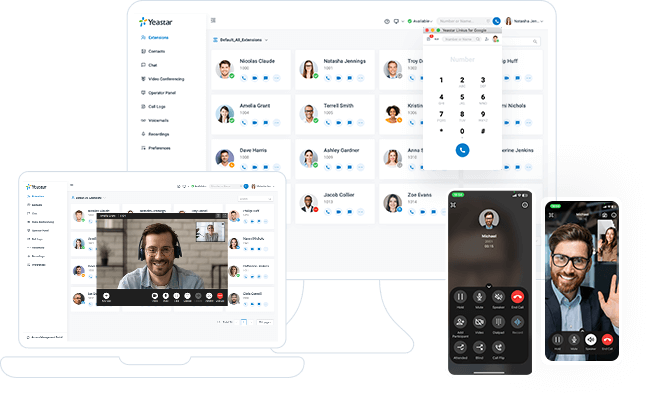What is SIP trunking?
SIP trunking is the virtual version of an analog phone line. Unlike the PSTN, ISDN BRI, or T1 lines that rely on physical wiring, it converts voice signals into digital packets, which are then transmitted over the Internet Protocol (VoIP) technology.
By using Session Initiation Protocol (SIP), companies can consolidate their voice and data networks, resulting in cost savings and streamlined operations. The service is usually provided by an Internet Telephony Service provider (ITSP) and often works with SIP-based business phone system (PBX) to enable daily functions of audio & video calls.
A SIP trunk provider delivers SIP trunking services, which let you make voice calls and share multimedia over the internet (VoIP). This modern technology is a key part of Unified Communications (UC), helping businesses bring together voice, video, and text into one simple, integrated system.
How does SIP trunking works?

SIP trunking establishes a connection between your business phone system and the Internet Telephony Service Provider (ITSP) through the Internet. Voice and data traffic are transmitted over this connection, allowing for voice, video, messaging, and more communication features.
There are two options for implementation:
Option 1: Using a Gateway
If you are using an analog phone system that doesn’t support the SIP trunk, you will need a VoIP gateway that acts as a bridge between the existing PBX system and the SIP trunk. The gateway translates the voice signals from the PBX into digital packets compatible with IP networks, allowing communication with SIP-based service providers.
Option 2: Adopting a Modern PBX System
Alternatively, you have the option to directly purchase a modern phone system with native SIP support, eliminating the need for additional gateways. Once connected, SIP trunking enables efficient and cost-effective communication, allowing businesses to make and receive calls over the Internet using VoIP technology.
Learn more about the Yeastar modern phone system. →
Selecting the Right ITSP
If you are ready to transition from traditional phone lines to SIP trunking, it is crucial to carefully select an Internet Telephony Service Provider (ITSP). Consider the following important factors:
Security & compliance
Competitive pricing
Technical support
Network Control
Extensive network coverage
Ability to port all phone numbers
Compatibility with existing phone system
Yeastar understands these factors and is committed to ensuring interoperability with global ITSP partners through in-depth testing. Until now, Yeastar has 150+ ITSP partners worldwide. These SIP trunking providers have been tested for compatibility with all series of Yeastar phone systems. Also, Pre-configured templates are included in the PBX management portal to make configuration easy and quick for you.
Check the full list of Yeastar certified SIP trunk providers→
Add UCaaS to Your Portfolio: Explore Yeastar UCaaS solution for ITSPs and Service Providers →
What Is SIP Trunking Used For?
In simple terms, SIP trunking is the modern way to connect your business’s phone system to the outside world over the internet. It’s essentially a digital replacement for the physical phone lines (like PRI circuits) that companies used to rely on.
Businesses use it to make their communication systems more flexible, affordable, and powerful. Here are the most common ways it’s put to work:
Powering Unified Communications: It’s the backbone that lets you blend voice calls, video conferencing, instant messaging, and file sharing into a single, seamless platform for better team collaboration.
Handling Fluctuating Call Volume: You can instantly scale your call capacity up or down. This is perfect for seasonal rushes or marketing campaigns, all without needing a technician to install new hardware.
Supporting Remote Work: It gives remote and mobile employees secure, reliable access to the company phone system from anywhere, making them just as reachable as if they were at their desk.
Establishing a Virtual Presence: SIP trunks allow you to easily get local phone numbers in other cities or countries, helping you build a local reputation for customers without needing a physical office there.
SIP trunking handles all the technical stuff: setting up, managing, and ending calls. Because it’s so flexible and internet-based, you can stop worrying about phone lines and focus on what matters: running your business.
Comparasion of Business Communication Solutions
Quick Overview: PRI vs. SIP Trunking vs. VoIP
Think of it in layers: VoIP is the underlying technology that defines how voice is packetized and transmitted. SIP Trunking and PRI are two different methods or services for connecting your PBX to the Public Switched Telephone Network (PSTN).
- PRI (Primary Rate Interface): A traditional digital phone line that physically connects your PBX to the public telephone network (PSTN) using TDM (Time-Division Multiplexing) technology.
- SIP Trunking: A modern, virtual alternative to PRI. SIP trunks use your internet connection to link your PBX to the PSTN via a SIP provider, eliminating the need for physical phone lines.
- VoIP (Voice over Internet Protocol): The core technology that converts voice into digital data and sends it over IP networks — enabling calls via LAN, WAN, or the internet.
You may need to know: SIP Trunking vs VoIP: What’s the Difference and Which One Do You Need?
The Expert’s Comparison Table
| Aspect | PRI (The Legacy Workhorse) | SIP Trunking (The Modern Standard) | VoIP (The Core Technology) |
| Technology | TDM (Time-Division Multiplexing) | IP (Packet-Switched) using SIP | IP (Packet-Switched) |
| Infrastructure | Physical T1/E1 Circuit | Virtual Connection over Internet/WAN | Runs on any IP Network |
| PBX Interface | Physical PRI Card | Session Border Controller (SBC) | IP Network Interface |
| Scalability | Physical Hardware Limit | Instant, Software-Based | Limited only by bandwidth & licensing |
| Cost Model | Per-Circuit, Per-Minute LD | Per-Channel, Per-Minute, Flat Rate | N/A (Enabling Technology) |
| Disaster Recovery | Complex & Costly (e.g., Redundant PRI) | Native & Agile (Geographic Redundancy) | Inherits from its transport |
| Best For | Environments where internet is unreliable; Strict compliance with legacy telco SLAs. | Nearly every modern business seeking cost savings, flexibility, and business continuity. | Any organization using an IP-PBX or hosted phone system. |
Benefits of SIP Trunking
SIP trunking offers numerous advantages over legacy phone lines, making it an attractive option for businesses.
Leverage a modern phone system: Directly connect Yeastar phone system to the SIP Trunk and embrace easy-first unified communications with a suite of advanced features. You can go on-premise or cloud-based, the choice is yours.
Cost savings: Eliminate physical phone lines and related hardware costs, resulting in lower monthly expenses for line rental and DID.
Easy scalability: Add or remove SIP trunks as your communication needs change, ensuring flexibility and cost-efficiency.
Uninterrupted connectivity: Continuous communication is assured with the internet connection, providing a reliable backup solution in case of traditional landline failures.
Expanded geographic reach: No location constraints. Easy to move office locations with original numbers.
Enhanced customer experience: Add regional and international numbers to your sip relay for more choices at a lower cost, improving convenience for customers.
Who can benefit from SIP trunking services?
Simply put, any business with a phone system can benefit. It’s ideal for:
- Companies with an existing on-premise PBX looking to reduce phone bills and modernize.
- Businesses with multiple locations that want to connect branch offices seamlessly and for free.
- Call centers and sales teams that need to scale call capacity up or down quickly.
- Remote or hybrid teams that need professional phone system access from anywhere.
- Organizations prioritizing disaster recovery to keep phones online during an outage
How to choose the right SIP trunk provider?
When selecting a SIP trunk provider, consider these key factors to ensure reliable and cost-effective communications:
- Network Reliability: Look for providers with high uptime guarantees, robust infrastructure, and multiple redundant routes.
- Voice Quality: Ensure the provider offers HD voice and low latency for crystal-clear calls.
- Security: Choose providers with strong encryption, fraud prevention, and compliance with industry standards.
- Scalability: Select a solution that can easily grow with your business—adding channels or locations as needed.
- Global Coverage: If you have international needs, verify the provider’s reach and local number availability.
- Support & Service: Prioritize providers with responsive technical support and transparent SLAs.
- Integration: Confirm compatibility with your PBX system and other business applications.
- Pricing & Flexibility: Compare pricing models, contract terms, and included features to find the best value.
Common FAQs About SIP Trunking
Related Features

The complete communications solution
Available both in the cloud and on-premises, Yeastar P-Series Phone System unites calls, video, omnichannel messaging, integrations and more in one simple system for your seamless communications anywhere.
Get started with 30-day free trial
Create your Yeastar phone system in minutes & see what all-in-one communications can do for your business today.
X
